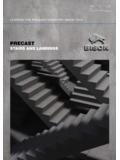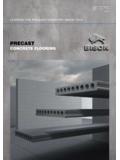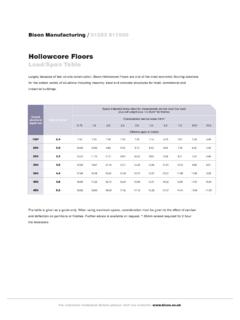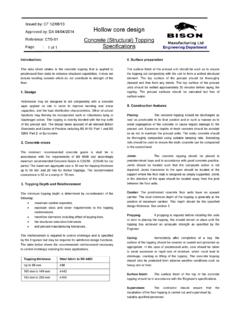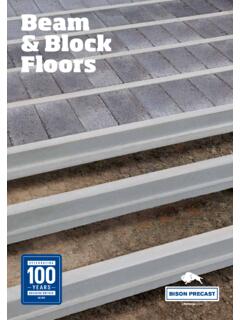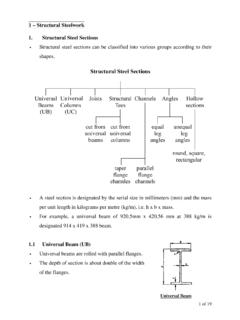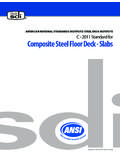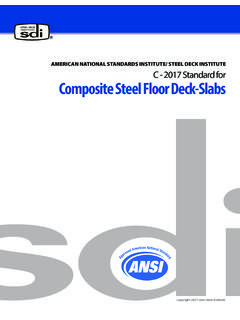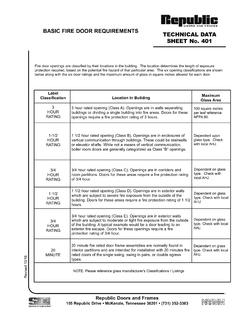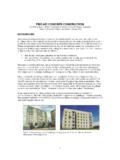Transcription of Flooring Specification - Bison Precast
1 Flooring Specification 1. SCOPE OF Specification Floor Types: This Specification covers the design, manufacture and associated site work for the following floor types; Hollowcore Floors Composite Hollowcore Floors Solid Composite Floors Description of Floors The Precast floors are designed and manufactured as pre-stressed Precast floors. Hollowcore floors are pre-stressed Precast floors with a series of holes through the section. Composite Hollow core floors consist of pre-stressed Precast floors with a series of holes through the section. The load capacities of the floors are enhanced by the provision of a structural concrete topping on site. Solid Composite floors consist of solid pre-stressed planks with a structural topping on site. 2. MATERIALS Standards: All materials and finished products are to be in accordance with the appropriate British Standards and this Specification .
2 Concrete: The compressive strength classes used in the design and manufacture of the units are as follows:- The compressive strength at 28 days is C45/55 The concrete strength at transfer is C25/30. Admixture: An admixture complying with BS EN 934-2: 2009 will be included in the concrete. reinforcement : reinforcement is generally 5mm diameter high tensile wire or strand complying with the requirements of BS 5896:1980. 3. DESIGN Code: The design of Bison units is in accordance with the requirements and recommendations of BS 8110:1997 The Structural Use of Concrete . Service Class: The design of Bison units is to Serviceability Classification, Class 3 with a limiting crack width of Design to other classifications can be provided if requested. Durability: The standard Bison Hollowcore slab is designed to comply with the durability requirements of BS 8500: 2006. July 2012 Fire: Fire resistance is based upon the tabulated data contained within BS 8110: Part 2, Section 4.
3 Sections are available for fire periods of 1 hour or 2 hours without additional finishes. These periods of fire resistance may be further enhanced by the application of appropriate finishes. Sound: The requirements of the Building Regulations and details of compliance are contained in a separate data sheet, which can be supplied on request. Horizontal and Vertical Ties: Ties necessary to satisfy the requirements for accidental damage should be specified by the Engineer with the responsibility for the design of the overall structure in accordance with the relevant Codes of Practice. Tying details achievable with our Hollowcore units are contained in a data sheet which is available on request. Composite Design: Where Bison Hollowcore/Solid plank units are designed to form part of a composite floor construction, the completed composite floor requires a structural concrete topping. The structural topping, grouting between Precast units and distribution reinforcement to be provided and placed by others to our recommendation.
4 We shall provide Precast units in our standard widths, and to make up the complete floor area it may be necessary for full depth insitu strips to be used. Such insitu strips inclusive of reinforcement to be provided and placed by others to our recommendation. Thermal Insulation: Bison Hollowcore units can be supplied with polystyrene insulation glued to their bottom soffit. This is to provide the necessary thermal transmittance (u-value) in accordance with the Building Regulations, Part L. 4. MANUFACTURE Method of Manufacture: Bison floors are manufactured by the long line pre-stressed method using slip-form or extrusion techniques. The units are cast and cured on steel beds within an enclosed factory environment. Ends of Units: Bison units are sawn to length on the manufacturing bed and are supplied as standard with plain sawn ends, with open cores or reduced ends. Dimensions: Bison units are manufactured in nominal widths of 1200mm.
5 Solid planks: Depths 60 mm, 75 mm and 100 mm Hollowcore: Depths 150, 200, 250, 260, 300, 350, 400 and 450 mm Permitted Deviations: Tolerances are set out in clause of BS 8110:1997. Length tolerances are + 20mm. Camber: Bison units will have an upward camber due to the pre-stressing force as described in clause of BS 8110:1997. Due allowance should be taken when specifying screeds, finishes, partitions etc for upward camber together with differential camber between adjacent units. The camber will vary between adjacent units and can give rise to a piano key effect. It maybe possible to reduce the camber between units by loading prior to the joint between the units being grouted. Finishes: Unless stated in Bison s quotation, concrete surface finish to soffits is a Type A finish as described in clause of BS8110:1997. The standard of finish referred to is as per the sample panels located at our production facilities.
6 July 2012 The soffit is suitable for the direct application of a textured (high build) paint finish where this is applied in accordance with the manufacturer s instructions. A caulking layer to the soffit may be required for other types of paint finish. Where a plaster finish is intended it may be necessary to use a bonding agent in accordance with the instructions of the plaster manufacturer. Plaster finishes are not recommended on longer spans. Sides and top surfaces are as extruded as described in Table of BS 8110:1997. To achieve a reasonably level surface to accept the resilient layer, it may be necessary to undertake local levelling to accommodate the manufacturing and construction tolerances. Infill Strips: Except where noted otherwise, our quotation allows for the design and provision of the floor areas indicated.
7 We shall maximise the use of our standard Flooring products, but to achieve complete areas it may be necessary, in certain instances, to use in isolation or in combination special cut width units or insitu strips. The width of such cut width units or insitu strips shall be at Bison s discretion. With Hollowcore or solid plank units 100 or 150 mm nominal wide strips of Bison special Precast infill pieces may also be used. To achieve complete areas it may also be necessary in certain instances for us to design full slab depth insitu strips to be reinforced and provided by yourselves. Such insitu strips will be shown on our working drawings. Edge of Unit: Edges are shaped to form a grout joint giving a shear key to distribute load to adjacent units. Where special cut width units are provided the edge will be rough cut from a standard unit. Cantilevered Balconies: Where quoted, Flooring behind cantilevered balconies is designed as composite construction using a combination of Precast Flooring and structural concrete topping.
8 We shall provide the complete composite construction. Requirements for temporary propping will be identified on our working drawings. Holes and Cut-Outs: All factory formed holes and cut-outs will be of rough appearance and are formed subject to the design capacity of the slabs. Due to manufacturing techniques, holes and cut-outs may be larger in the transverse width of the slab than specified. Manufactured hole sizes will be shown on the drawings. Holes may be either rectangular or circular depending on the manufacturing techniques employed. 5. SITE WORK Standard: All site work is to be undertaken in accordance with the best current practice and Health & Safety legislation. Drainage Points: Water may accumulate within the cores due to exposure during the construction programme. Unless otherwise instructed Bison will provide drainage points in slabs with factory formed reduced / troughed / solid / capped ends only.
9 Water may seep out of units for a considerable time after installation and the drain holes may not be neatly formed. The Customer is responsible for opening out drainage points, keeping them clear during construction and for subsequent infilling / making good as required. Water trapped in the cores may present a risk to operatives from the alkaline state of the water. Notching: Where slabs are notched around stanchions, columns or similar obstructions, these will be of rough appearance (see also clause ). Unless expressly stated in Bison s quotation, any resultant infilling between slab and stanchions, columns or similar obstructions within the depth of the slab is to be carried out by others. July 2012 Anti-Crack Provision: It is recommended that light mesh reinforcement be provided by others in the insitu screed over all supporting steel beams, in order to minimise the possibility of latent cracking in finishes.
10 Thermal Insulation: It is recommended that thermal insulation should be provided on roof areas and the breaks should be made in plaster at junctions between our works and other materials. Trimmer Angles: Any steel angle provided by Bison to trim large openings is to be fire protected by others. Bearings: Level and structurally adequate bearings for Bison Precast units are to be provided by others. Bearings should generally be 100mm for masonry or 75mm for concrete or steelwork, but may be reduced in accordance with clause of BS 8110:1997 or after consultation with Bison s Engineering Department. It is Bison s Customers responsibility to ensure that all bearings have been designed appropriately to take into account of temporary loads during erection. Shelf Angles: In cases where the Bison slabs fit under the top flange of steel beams or columns, it is assumed that the dimension from the top of the slab down to the flanges will not exceed 25 mm.

